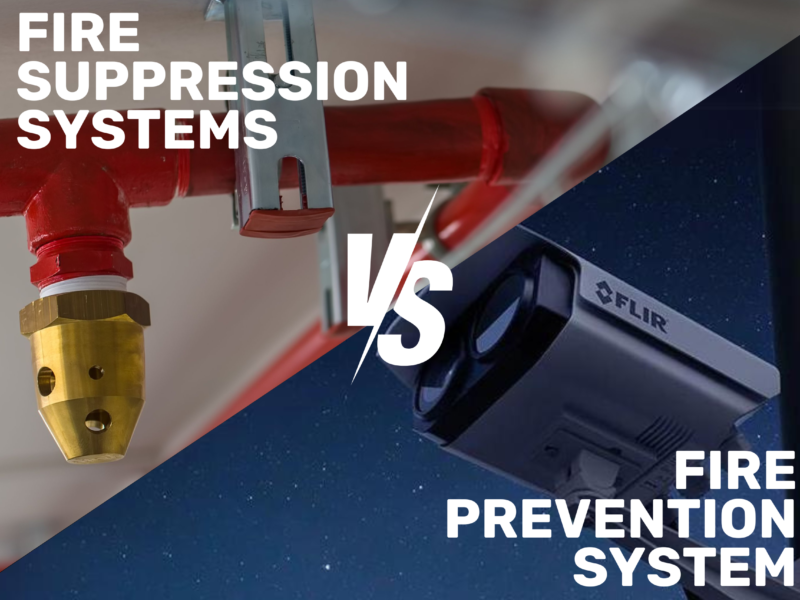When it comes to fire safety, choosing the right system can mean the difference between life and death, or property damage and preservation. The debate between thermal imaging cameras and sprinkler systems is common among fire safety experts. In this article, we explore the key differences, advantages, and limitations of both systems, ultimately making the case for why thermal imaging cameras offer a more comprehensive and efficient solution.
Understanding Fire Prevention & Safety Technologies
Before delving into the comparison, let’s define each system:
- Sprinkler Systems: These are automated systems that spray water when a fire is detected. Sprinklers have been a staple in fire safety for decades, particularly in commercial buildings, warehouses, and high-rise complexes.
- Thermal Imaging Cameras: These devices detect heat signatures, allowing them to spot fire risks before they escalate. Thermal imaging cameras are becoming more popular in fire prevention and safety applications.

The Limitations of Sprinkler Systems for Fire Prevention
Sprinkler systems, while effective in suppressing fires, have several significant limitations:
- Activation Lag: Sprinkler systems typically activate after flames have reached a certain temperature, often resulting in extensive damage by the time the sprinklers engage.
- Water Damage: While sprinklers extinguish fires, they also cause significant water damage to property, leading to additional repair costs and business interruptions.
- False Alarms: Sprinkler systems can be triggered by non-fire-related factors such as steam or heat from equipment, causing unnecessary water discharge.
- Maintenance and Testing: Sprinklers require regular testing and maintenance to ensure they work correctly, adding ongoing costs to building management.

The Advantages of Thermal Imaging Cameras for Fire Prevention
Thermal imaging cameras offer several advantages over sprinkler systems:
- Early Detection: Thermal imaging cameras can detect heat anomalies, enabling fire safety teams to respond to potential risks before they become full-blown fires. This early detection can prevent significant property damage and reduce safety risks.
- Minimal Disruption: Because thermal imaging cameras do not rely on water to suppress fires, they eliminate the risk of water damage, reducing the impact on business operations and property.
- Precision: Thermal imaging cameras can identify specific sources of heat, allowing targeted interventions and reducing false alarms.
- Enhanced Safety: These cameras can be used to monitor large areas, providing real-time information to fire safety teams. This capability can improve response times and enhance overall safety.
- Integration with Other Systems: Thermal imaging cameras can integrate with building management systems, offering a comprehensive approach to fire safety that can be monitored remotely.
- Lower Insurance Premiums: As thermal imaging prevents fires rather than suppresses them, insurance company’s often quote a dramatically lower cost.

The drawbacks of Thermal Imaging Cameras
While thermal imaging offers many benefits for fire prevention, there are some drawbacks compared to traditional sprinkler systems. Here are a few considerations:
- Limited Fire Suppression: Unlike sprinkler systems, thermal imaging cameras detect heat but don’t physically suppress fires. Additional fire suppression systems are still needed, adding to overall costs.
- False Positives: Thermal cameras can detect heat sources that are not fire-related, such as machinery or lighting. This can lead to false alarms or unnecessary responses.
- Complex Integration: Integrating thermal imaging into existing fire safety systems can be challenging. It often requires additional software and infrastructure changes.
- Regular Maintenance and Calibration: Thermal imaging cameras require regular maintenance and calibration to ensure accuracy.
- Power Dependency: Thermal cameras rely on electrical power, so a power outage could affect their operation. Sprinkler systems are generally more resilient during power failures.
- Limited Detection of Smoke: Thermal imaging focuses on heat detection, whereas smoke detectors and sprinkler systems are designed to detect smoke and fire-related gases. This means that thermal cameras might not alert to smoke as quickly as other systems.

Why Thermal Imaging Cameras are the Future of Fire Prevention
While sprinkler systems have long been the go-to solution for fire safety, thermal imaging cameras represent a more advanced and effective approach. With the ability to detect fires before they start, thermal imaging cameras offer an additional layer of safety and significantly reduce the risk of property damage and business interruption.
In summary, thermal imaging cameras provide a proactive approach to fire safety, focusing on early detection and prevention. This capability, coupled with their precision and integration potential, makes them a superior choice compared to traditional sprinkler systems. If you’re seeking a fire safety system that minimises risk and maximises protection, thermal imaging cameras should be at the top of your list.
Thermal Imaging Cameras Used to Protect Incineration Plants
Contact Us To Find Out More….
☎️ 01772 330 777
Email us at 📧 info@bi3.co.uk


 Introducing MudCam: The Mud-on-Road Detection System
Introducing MudCam: The Mud-on-Road Detection System